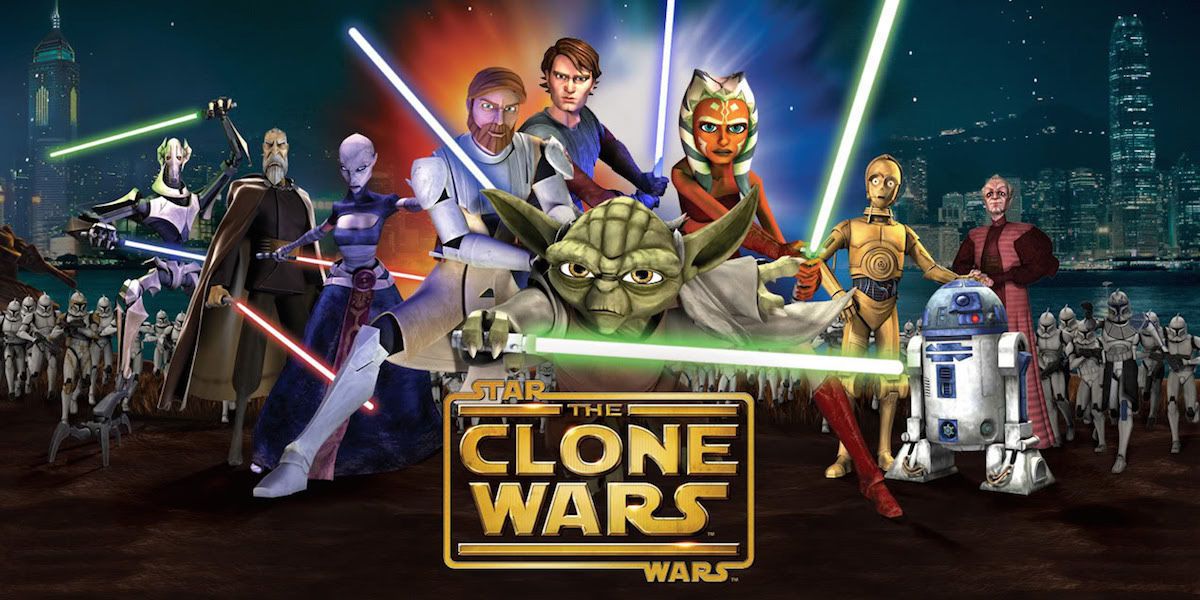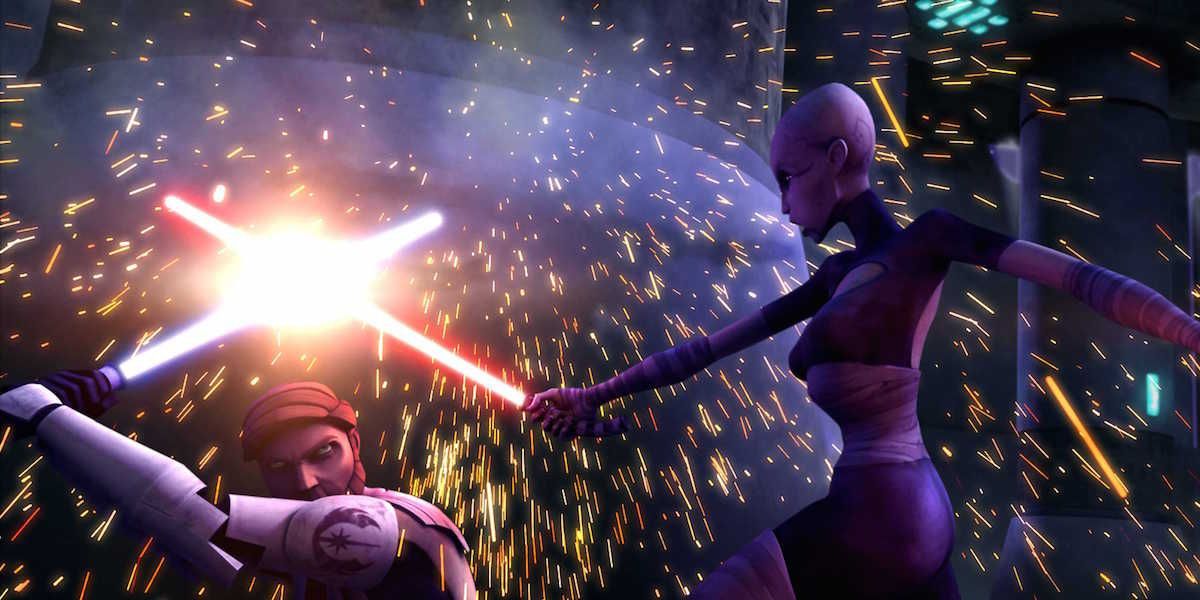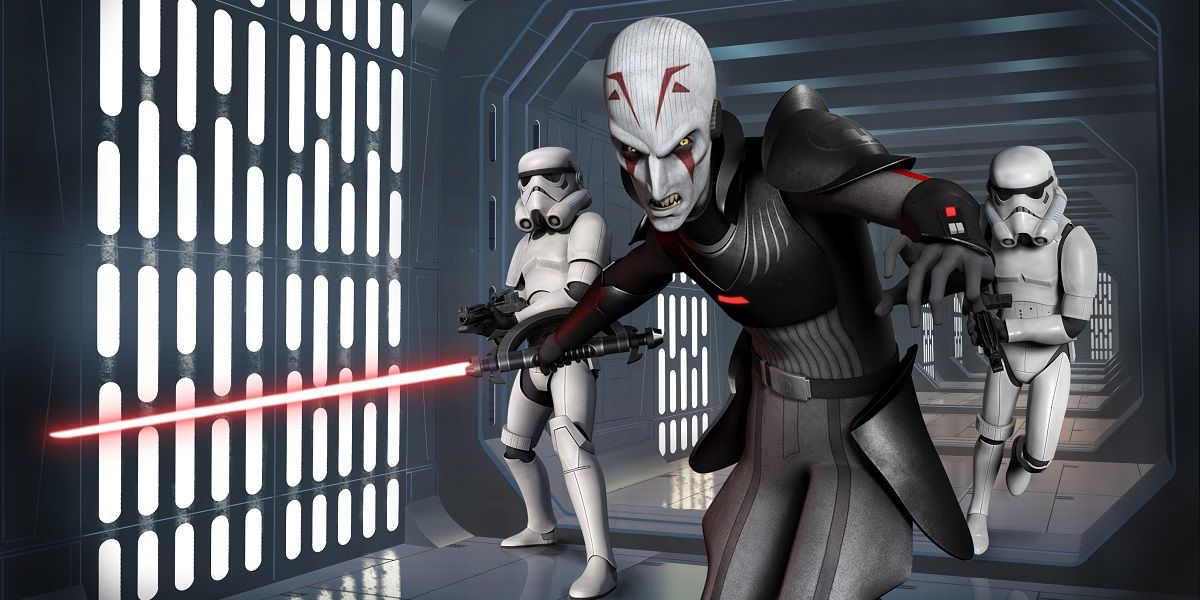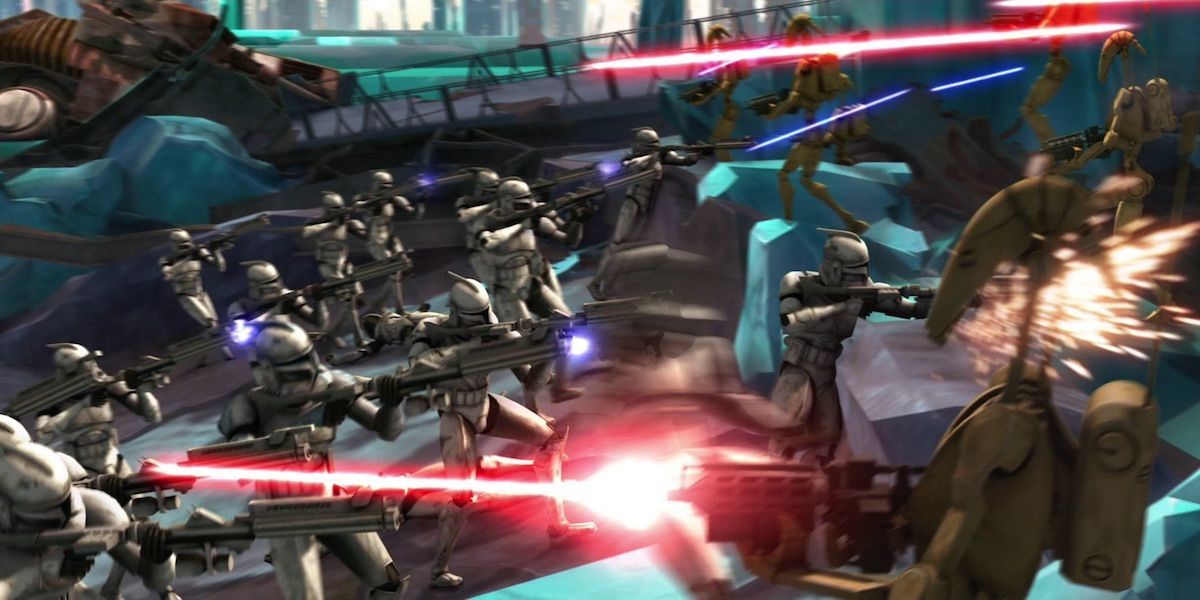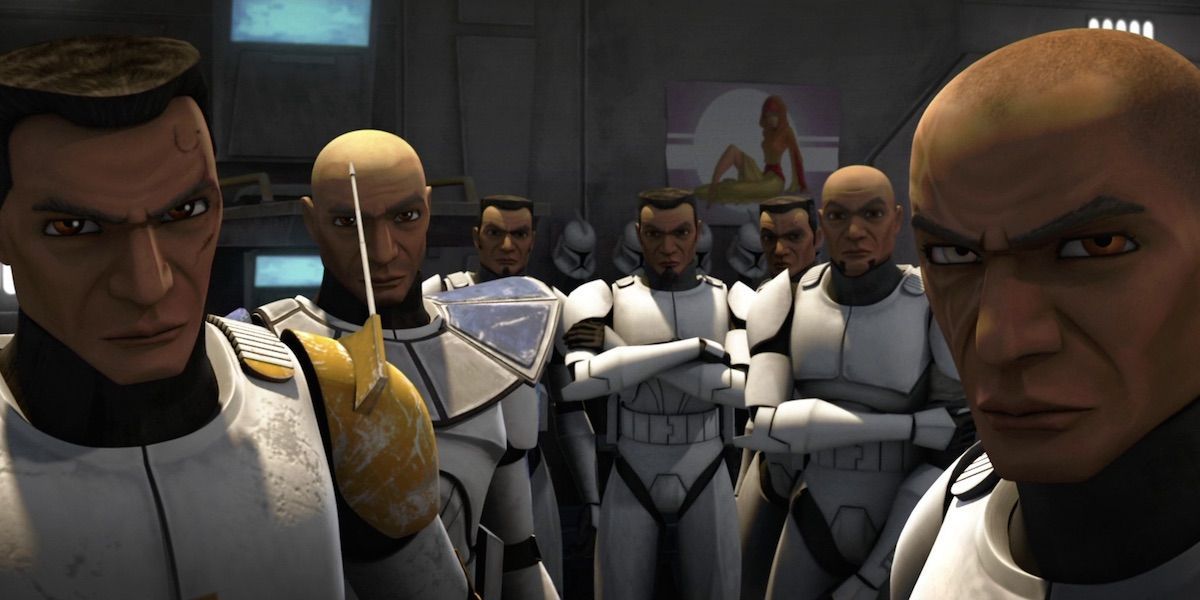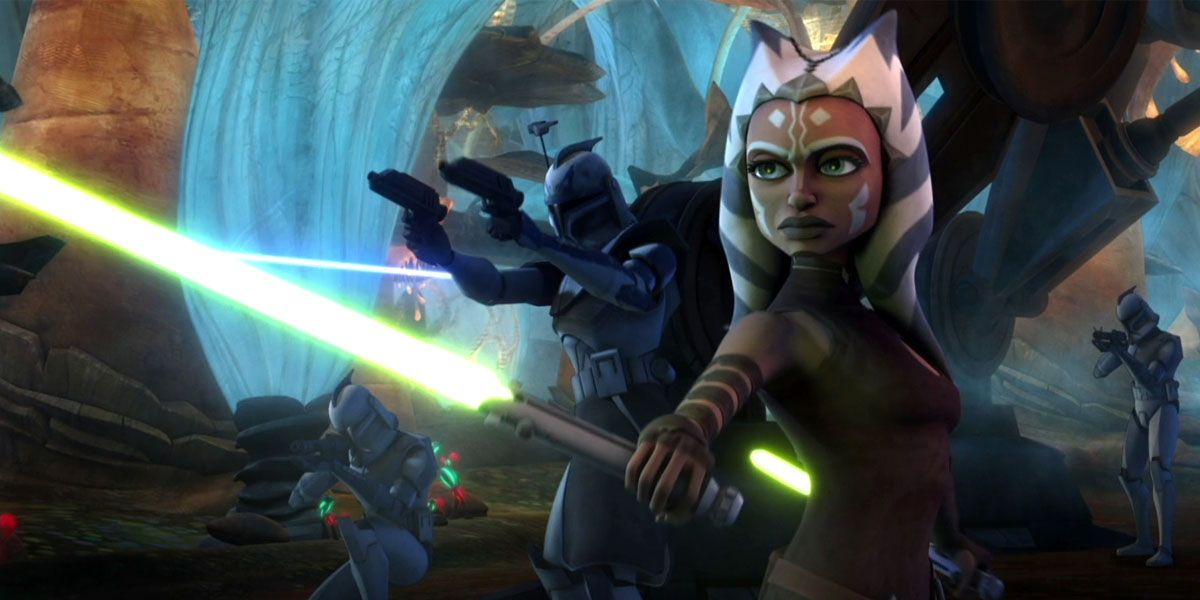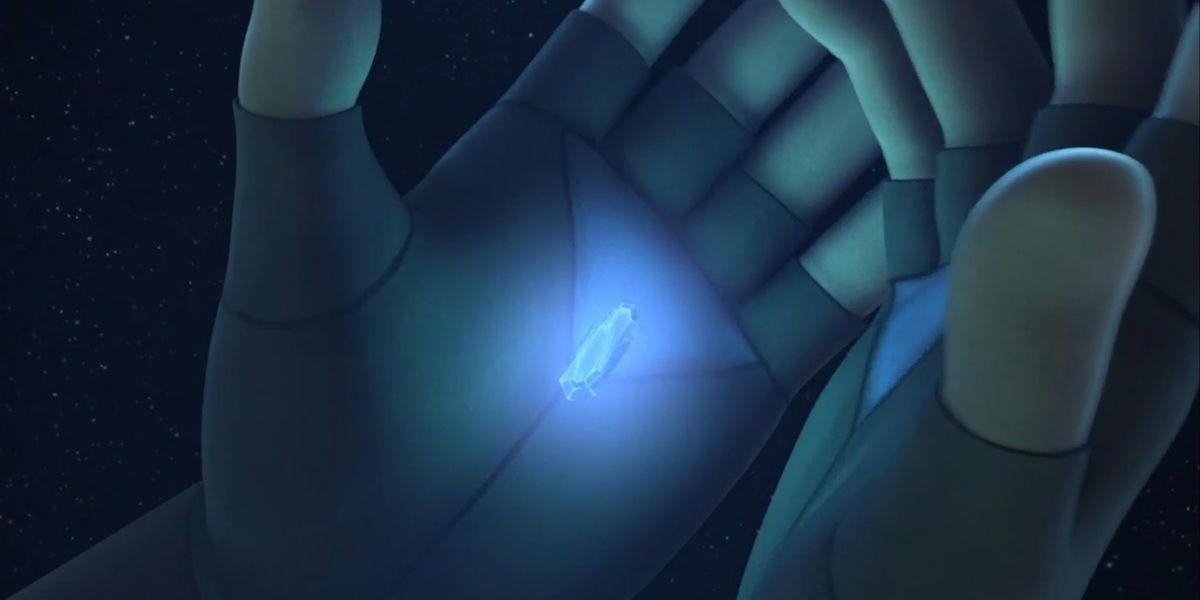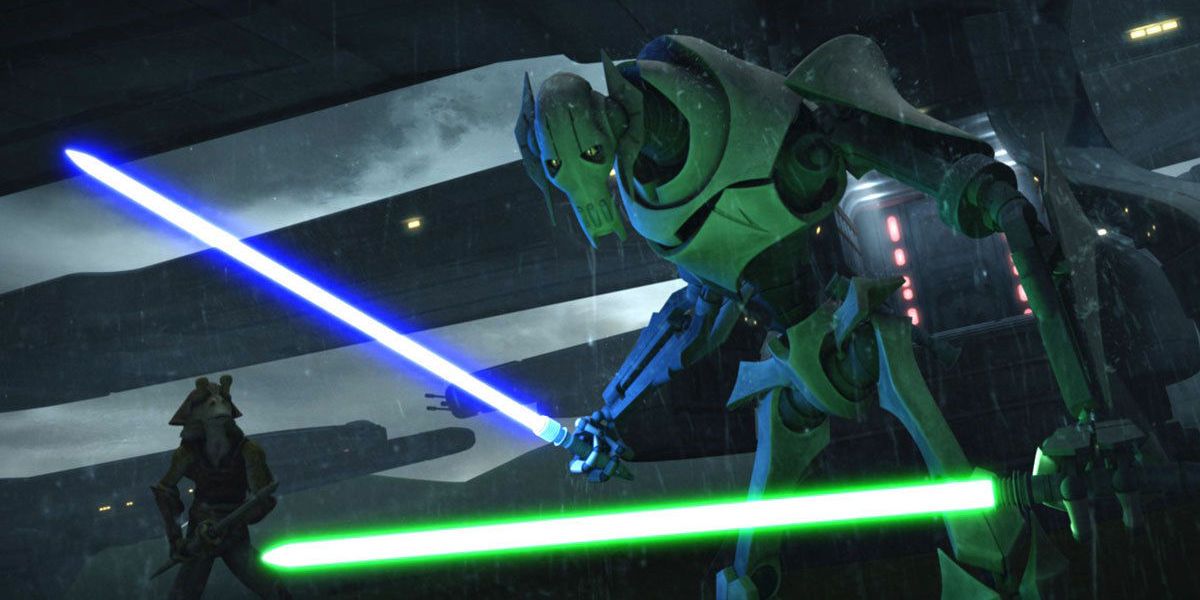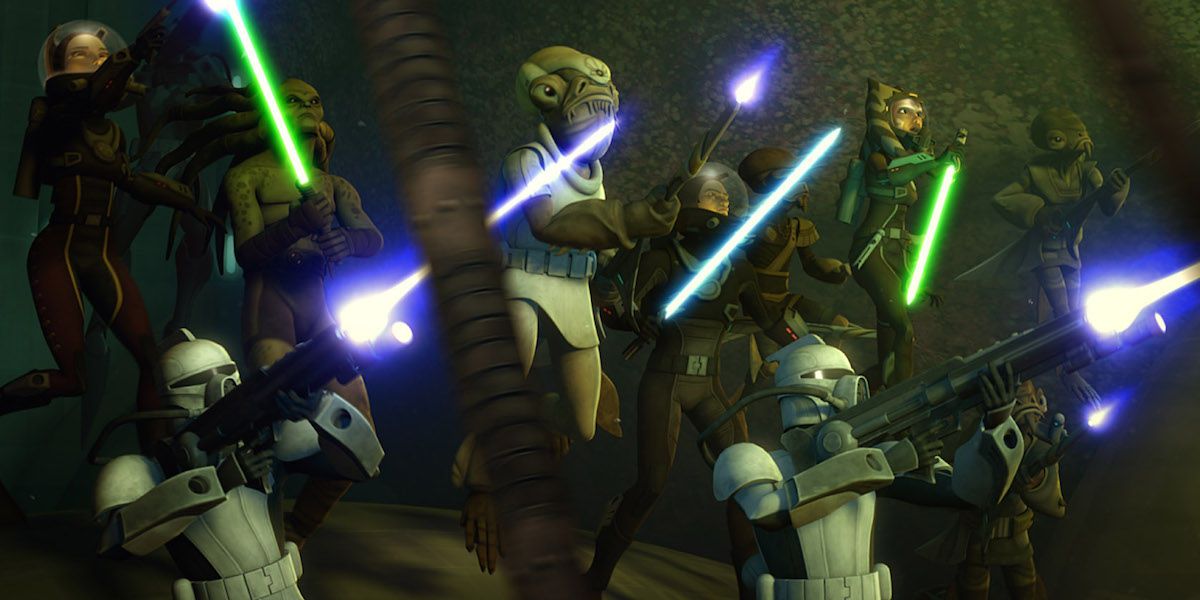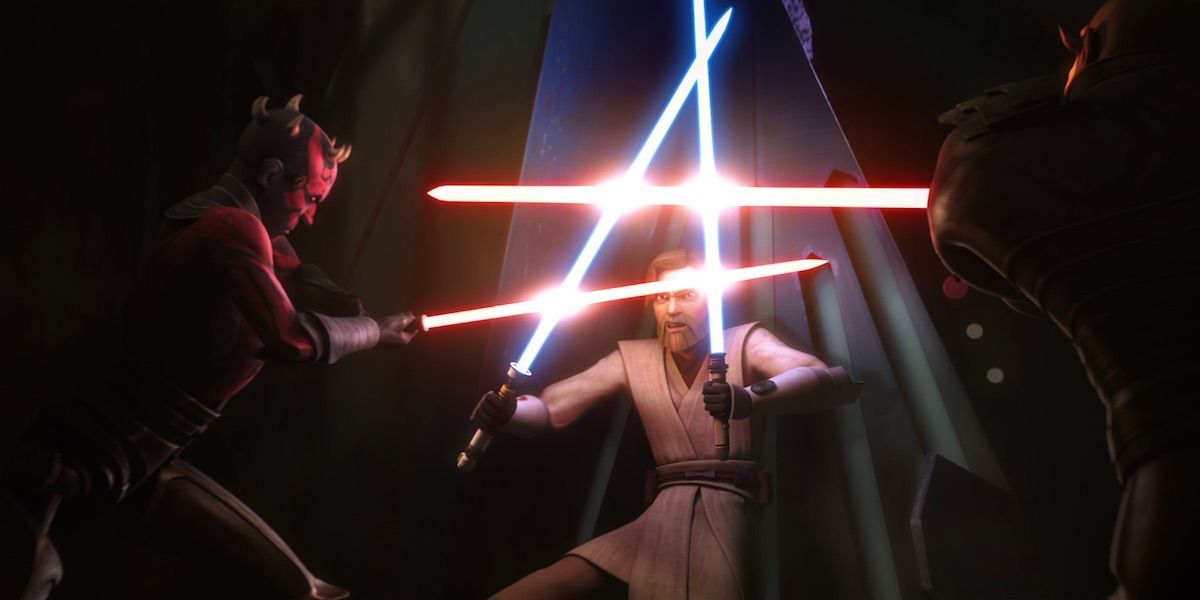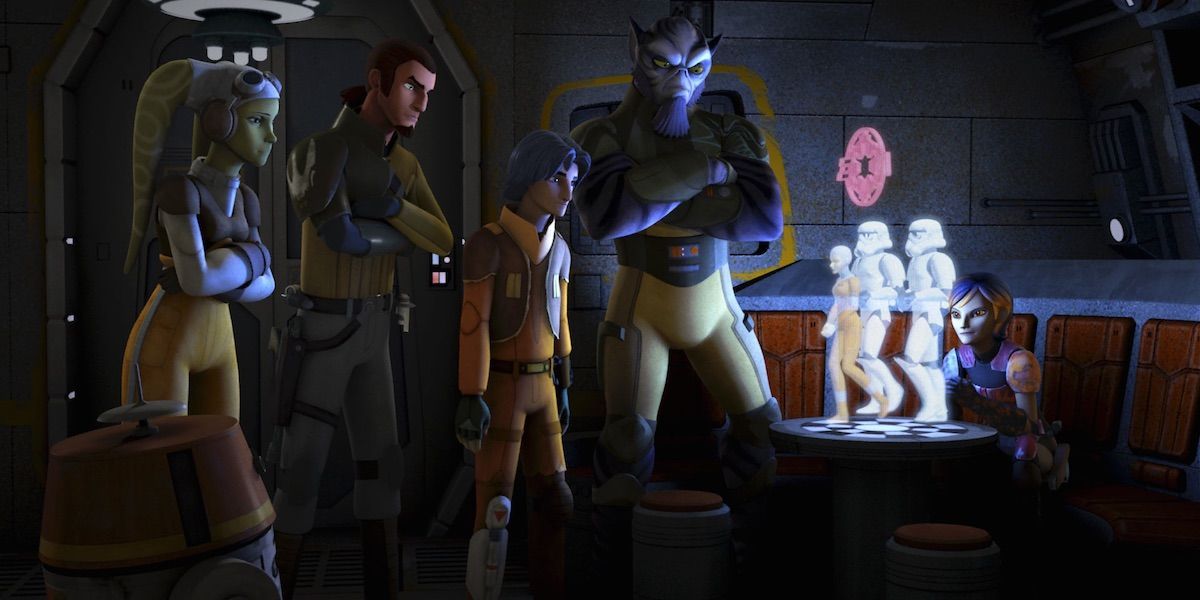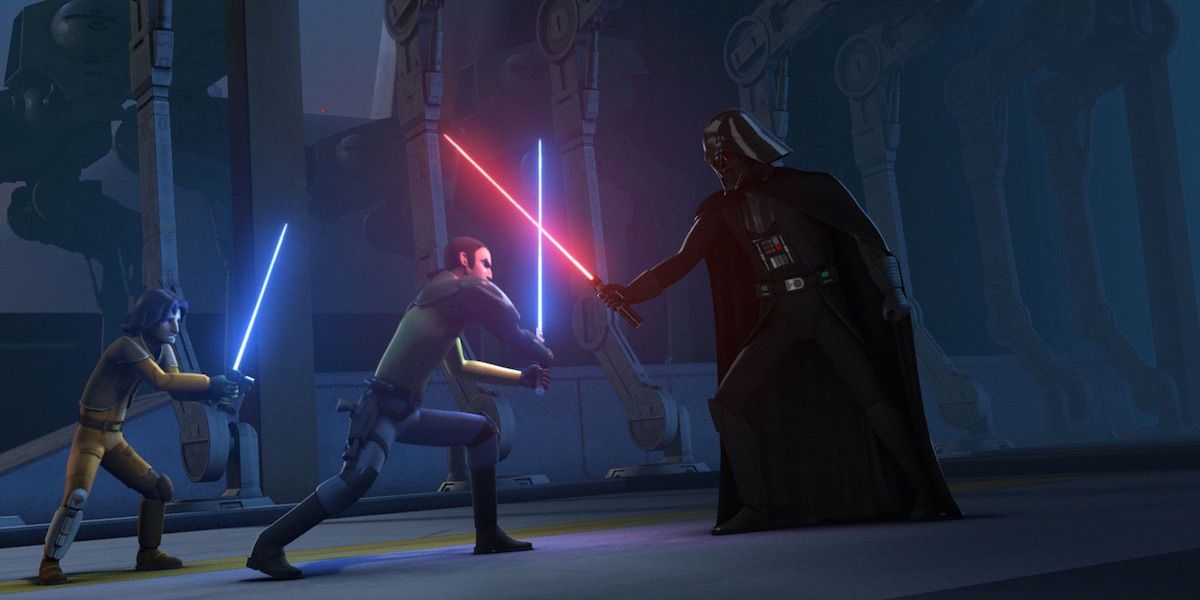For Star Wars fans that endured a sixteen year wait between Return of the Jedi and The Phantom Menace, only to be disappointed by the prequel trilogy and left unsure whether they'd ever get to journey to A Galaxy Far, Far Away again, the acquisition of Lucasfilm by Disney came as a very welcome surprise. While longtime Force-enthusiasts salivated over the prospect of a new film trilogy and anthology spinoffs, not to mention merchandise, the studio unceremoniously axed the entire Expanded Universe - to ensure director J.J. Abrams had a clean post-Episode 6 slate to craft his own path (read: not beholden to fan-favorite EU storylines, such as Timothy Zahn's Thrawn trilogy).
Nevertheless, the studio refrained from sidelining its own in-house animated prequel project Star Wars: The Clone Wars - even creating an all-new series, Star Wars: Rebels, to continue building the franchise canon on the small screen ahead of Star Wars - Episode 7: The Force Awakens. However, despite the official Lucasfilm stamp of approval, many longtime fans never embraced the series - dismissing it as a brainless animated offering for the juice box crowd. While initial episodes of The Clone Wars definitely leaned on kid-friendly hijinks (and regular appearances from detested prequel characters like Jar Jar Binks), the series evolved over its 5.5 seasons into a thoughtful and earnest expansion of Star Wars mythology - one that fills in a lot of gaps between Star Wars: Episode 2 and 3, as well as sheds light on characters and larger world-building that went underserved by George Lucas.
With Star Wars: Rebels on a similarly ambitious path, and Star Wars - Episode 7 fast approaching, here are 10 reasons why The Clone Wars and Rebels are essential viewing ahead of The Force Awakens.
11. They Justify the Legends
Throughout Star Wars episodes 4 - 6, characters often reflect upon the days when Jedi Knights protected the Galaxy from Sith Lords - telling tales of the Jedi Order's wisdom and bravery. Han Solo might describe Lando Calrissian as a hustling scoundrel and Rebel soldiers cower in fear before Darth Vader, but a lot of Star Wars series character development is implied through exposition - despite a rich history in the Galaxy Far, Far Away. With the exception of Luke Skywalker, viewers meet most of the primary Star Wars cast in medias res - with their role in the larger tale already set. The prequels attempted to add backstory but only focused on a small group of people instrumental to the Skywalker bloodline and, unfortunately, many of these individuals simply did not live up to their own legends.
Thankfully, The Clone Wars directly shows why the characters become legends. Instead of a whiney love-sick teen, The Clone Wars depicts Anakin Skywalker as a valiant and powerful Jedi, struggling to do what he thinks is right, often succeeding through unorthodox (and reckless) means. Laying seeds for his dark turn, seeing the hero in his prime makes his fall all the more tragic and, similarly, makes his return in Rebels as Darth Vader all the more ominous - especially since the Rebels Vader is at his most terrifying and powerful.
10. They Explain & Expand The Force
George Lucas originally took a less-is-more approach to the mystical Force in his original Star Wars trilogy - only to undercut the mystery with an on-the-nose, and downright boring midi-chlorian 0ver-explanation in Star Wars - Episode 1. Instead of attempting to explain the science of the Force (as if it were a high school biochemistry class), The Clone Wars teaches viewers about the supernatural life-force through a variety of force-wielders. The Expanded Universe touched on Force-sensitive beings besides Jedi and Sith but The Clone Wars as well as Rebels directly brings other Force-users into the canon storyline.
Most notably, the Nightsisters (witches that exploit the Force through dark arts), The Ones (powerful beings embodying the dark, light, and balanced Force) and the Inquisitors (Force-wielding Jedi hunters) explore as well as explain how non-Jedi and Sith individuals can harness or exploit the Force. Instead of expository monologuing, the animated series introduces viewers to new characters who can manipulate the Force in previously unknown ways - and then showcases the extent, and also limitations, of their power. Additionally, the series also expands on Force mythology as Anakin grows increasingly stronger, shedding further light on the necessary balance (and subsequent grey area) between the light and dark side.
9. They Provide Scale
While the prequels leaned on CGI spectacle, The Clone Wars and Rebels offer a never-before seen sense of galaxy-building and scale. As mentioned, despite Anakin Skywalker's importance to the larger Star Wars universe, Episodes 1 - 6 are actually confined to a very limited progression of events, locales, and characters. Viewers visit exotic planets and meet strange inhabitants but aside from the Trade Federation threat in the prequels and Empire regime in the original trilogy, Lucas never quite sold how malevolent forces and the ongoing Clone War actually impacted life throughout the galaxy. Fans were given glimpses at the variety of alien species living on Coruscant as members of the Galactic Senate - but there were very few direct correlations to how Palpatine's manipulation of the Senate actually affected everyday people around the galaxy.
Conversely, given the mission-focused format of The Clone Wars and Rebels, viewers are treated to countless peace-keeping crusades around the Star Wars universe - ranging from light-hearted misadventures to downright tense battles that influenced the entire universe. In fact, many of the animated series' best and most memorable stories don't even depict face-offs between iconic characters; instead, they feature the titular clones, led by lesser-known Jedi Masters (like Plo Koon and Barriss Offee), rushing into war-torn regions in order to protect innocent lives or secure a strategic asset.
8. They Make Clone Troopers Special
Even after Star Wars - Episode 2, fans knew very little about the clone troopers - leading to the assumption that, under their stormtrooper-like helmets, the soldiers were nothing more than manufactured copies of bounty hunter Jango Fett. Revenge of the Sith showed that the clones had been given identifiable codenames, and even formed friendships with their Jedi commanders, only to then mindlessly turn weapons on the Jedi under swift execution of Order 66. The scene should have been a horrifying moment of revelation, as the troopers coldly turned on heroes they'd fought alongside for years; however, for moviegoers who never got to know the clones as anything more than interchangeable red shirts, the true horror of Order 66 fell flat.
Instead, The Clone Wars spends a significant amount of time developing individual clone heroes - many of which give their lives on the journey from season 1 to season 6. The animated series features entire episodes centered on clone battalions that, not only give insight into clone life, but also tell engaging tales of brothers in arms. As a result, the callous malevolence of Palpatine's puppetry is laid bare when, after three years of mutual respect and friendship between CC-2224 (aka Commander "Cody") and Obi-Wan Kenobi, as depicted in The Clone Wars, the trooper receives Order 66 in Episode 3 - and orders his squad to gun down their former ally.
7. They Highlight Great Female Characters
When the first cast image of Star Wars - Episode 7 was released online, it did not take long for fans to point out that, nearly forty years after A New Hope, the ratio of men to women in a Galaxy Far, Far Away was still very uneven. In the time since, we've learned that several other women will play pivotal characters in The Force Awakens - meanwhile Felicity Jones will lead the Star Wars: Rogue One anthology film. However, long before Disney was ensuring the live-action Star Wars revival would feature hero (and villain) actors of all genders and ethnicities, The Clone Wars, and later Rebels, were already featuring entertaining, badass, and downright profound, female characters.
In addition to further development of Padmé Amidala, as both a wartime senator and capable fighter, Jedi apprentice to Anakin Skywalker, Ahsoka Tano was initially introduced as a sidekick to the reckless Jedi Knight as well as a reflection of Anakin's personal struggles with attachment and fear. Yet, over the course of five seasons, Tano, became an important (and downright refreshing) figure in Star Wars canon. Tano's determination and sense of virtue also laid seeds for Rebels' female crew members Sabine and Hera - who, throughout season 1, were afforded many of the series' best storylines. That said, The Clone Wars didn't stop at female heroes, highlighting female dark side force-user, Asajj Ventress, that was more dangerous (and layered) than many live-action fan-favorites like Darth Maul.
6. They Indulge Fan Curiosity
By expanding the Star Wars story to an entire galaxy, rather than the core tale of a Jedi family that brings balance to the Force, The Clone Wars and Rebels have offered insight into a number of geeky subjects that fans had, previously, only debated with friends. In addition to further exploration (and development) of the titular clone troopers, along with the Jedi Order and early Rebel heroes (such as Bail Organa), both series have included standout mythology-building episodes. Example: "The Gathering" (The Clone Wars season 5) and "Path of the Jedi" (Rebels season 1) episodes feature young Jedi facing their fears in a rite of passage: finding the Kyber crystals necessary to construct their lightsabers.
While the Expanded Universe provided similar world-building for curious fans, The Clone Wars and Rebels present the canonical version of Star Wars mythology on which future films and TV series will be built. Offering answers to die-hard fan debates, the animated series explain how the wise Jedi Counsel failed to see Order 66 (and Palpatine's puppeteering) in time, as well as what life around the galaxy was like under the oppressive Empire prior to A New Hope, among other nerdy topics.
5. They Coordinate Canon
While George Lucas had good intentions for his Anakin-centric prequel trilogy, most longtime fans argue that Episode 1 through 3 muddled the franchise - rather than provided worthwhile backstory. A melodramatic love tale, CGI overload, whiney depiction of the galaxy's most powerful Jedi, and on-the-nose attempts to "explain" mysterious elements of the Star Wars film world led to a convoluted mix of key events in the journey toward Episode 4, rather than a nuanced depiction of a Phantom Menace that leads to a full Revenge of the Sith. Instead of a subtle story that could stand on its own, for many, the prequel trilogy came across as a cliff-noted (albeit still lengthy) prologue to Episode 4 and the introduction of Luke Skywalker.
Conversely, with 136 episodes (so far) between The Clone Wars and Rebels, Lucasfilm had plenty of time to fill-in big jumps within the larger Star Wars film canon (especially between Episode 2 and 3 as well as 3 and 4) - paving the way for lesser-known elements that factor into Episode 7 (such as non-Sith Jedi hunters like the Inquisitors) as well as making up for undercooked aspects of the prequel trilogy (via a more nuanced portrayal of Anakin Skywalker, the return of Darth Maul, and many pre-Episode 3 battles with General Grievous).
4. They Provide Fun & Interesting Easter Eggs
In addition to plugging holes in the live-action canon, a role the new Star Wars "Anthology" films are likely to fill going forward, The Clone Wars and Rebels also include a number of downright fun easter eggs, cameos, and nods to the series' history that will be especially fun for longtime fans. Between Rebels and The Clone Wars, viewers were treated to the return of established characters and locations in the universe - including Grand Moff Tarkin (who appears in both The Clone Wars and Rebels), the Mandalorians, and Yoda, as well as smaller cameos including Qui-Gon Jinn, "Captain" Ackbar, Greedo, and Chewbacca.
Just as The Clone Wars brought back Darth Maul to continue the underutilized villain's story after Episode 1, viewers who enjoy The Clone Wars will see a few especially welcome returns in Rebels as well - advancing the journey of fan-favorite characters that were not explored enough (or at all) in live-action. Inclusion of existing characters, especially Vader, might seem like a shameless PR move but with James Earl Jones back to voice the imposing Sith Lord and a new chapter in Anakin's story to explore, combined with an outright brutal fight between Vader and the heroes of Rebels, it's hard to be too cynical.
3. They Have Great Action
Following game-changing scale in the original Star Wars trilogy, Lucas had his work cut out for him when he decided to return with the prequel films. Instead of "better" action, the filmmaker opted for "bigger" spectacle - resulting in some genuinely imaginative scenes (such as Episode 1's podrace) but an equal number of bland CGI sequences that never captured the excitement of his first three installments. Despite showcasing Jedi Knights in their prime, the best action in Episodes 1 - 3 (arguably) occurs during the first chapter - peaking with Qui-Gon Jinn and Obi-Wan Kenobi's duel of the fates with Darth Maul.
Conversely, action in The Clone Wars and Rebels has only improved over time. The added benefit of animation allowed Lucasfilm to present the Jedi and Sith without concern for blending real-world physics with CGI elements. Darth Vader's introduction in Rebels captures the speed, raw power, and ruthless determination of the fallen hero better than most of his live-action scenes - while Clone Wars presents countless sequences of epic Clone Trooper and Jedi team-ups. The animated series feature many of the best lightsaber duels of the entire franchise - not to mention enormous battles (in space, underwater, and on land) that convey bravery, danger, and the thrill of victory through slick, inventive and, frankly, beautiful action set pieces.
2. They Tell A New Side to the Story You Know
Despite making a point of "Balance in the Force," the Star Wars films (even the original trilogy) are still a very basic tale of "Good versus Evil" - albeit with a few unscrupulous rogues thrown into the mix. The black and white approach to character works for the main narrative, with the focus squarely on Skywalker, and Lucas could throw a bad guy blanket over the entire Empire (as well as every single person under it). Yet, in expanding outside of the core Star Wars story arc, Rebels and Clone Wars shed new light on people the films might have otherwise lumped together.
In addition to the pro-Republic and pro-Rebel side, the animated series also chronicle people caught on the "wrong" side of the conflict - transforming the brainless Separatist story in the prequels (embodied by Nute Gunray) into a nuanced tale of everyday people, from all walks of life, trying to survive as war rages around them (as evidenced by Mina Bonteri and the Confederacy of Independent Systems). Similarly, Rebels sees Imperials second guess the Empire and turn to informing for the burgeoning rebellions. Spotlighting this larger, more-developed context, provides new insight into the Star Wars legend - as well as breathes fresh air into Lucas' overly-simplistic commentary on modern politics in Episodes 1 - 3.
1. They Are Critical to Getting the Full Story
As stated, many fans felt the prequels hurt rather than helped legendary characters in the Star Wars universe - portraying the Jedi as oblivious, Anakin as a crybaby, and failing to deliver a worthy antagonist capable of going toe-to-toe with Obi-Wan and other heroes. Intriguing new additions, such as Darth Maul and General Grievous were underutilized in favor of pushing the Separatist charade and maneuverings of Darth Sidious. However, where the prequels failed, the Clone Wars and Rebels succeed - not just by filling in surface-level plot threads (example: how did Boba Fett become a bounty hunter?) but by chronicling subtle nuances that inform how an entire Galaxy was manipulated by fear.
In particular, the Clone Wars and Rebels both showcase the fallibility of the Jedi Order, highlighting a very subtle line between duty and personal attachment. One storyline reveals Obi-Wan's struggle to balance romantic feelings for Duchess Satine (of the New Mandalorians) with his responsibilities to the Jedi Code - providing smart juxtaposition for Anakin's obsession with Padmé as well as elevating the concept of personal attachment, fear, anger, and hate out of melodrama into well-realized and relatable character drama. Of course, that's only one example but, between The Clone Wars and Rebels there have been countless other opportunities for Lucasfilm to flesh out themes and stories that were merely hinted at throughout the franchise - clearing the path for a better understanding of the full Star Wars story and its inhabitants ahead of Episode 7!

